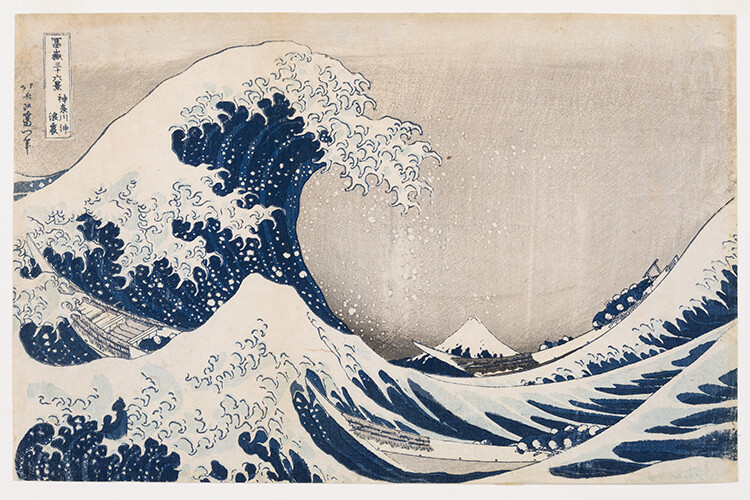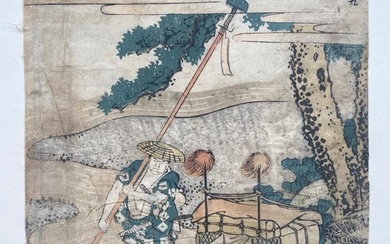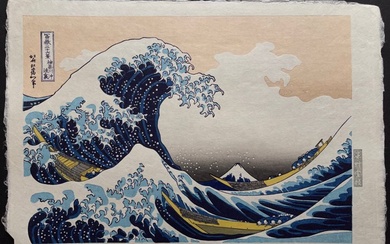Katsushika Hokusai
1760 - 1849
Japanese
Under the Well of the Great Wave Off Kanagawa
woodcut on paper, 1831
signed Hokusai aratame litsu hitsu
9 1/2 x 14 5/8 in, 24.1 x 37.1 cm
Preview at: Heffel Toronto – 13 Hazelton Ave
PROVENANCE
Collection of R.A. Laidlaw, Toronto
By descent to the present Private Collection, Ontario
LITERATURE
Martin Bailey, “How Van Gogh's Starry Night was inspired by Hokusai’s Great Wave,” The Art Newspaper, September 28, 2018
Oban yoko-e (standard horizontal format) woodblock print from the series ‘Thirty-six Views of Mount Fuji'. Published by Nishimura Yohachi (eijudo).
Without a doubt, Hokusai’s “Under the Well of the Great Wave off Kanagawa” (Kanagawa-oki Nami Ura) is one of the most iconic images in art history. It is perhaps the most recognizable example of Japanese art, and has been widely influential – helping to inspire the Japonisme movement in France and inspiring European Impressionist and Post-Impressionist artists through the late 19th Century.
Published around 1831 when the artist was 70 years old, “The Great Wave” is Hokusai’s most famous image from his series “The 36 Views of Mt. Fuji,” a publication of ukiyo-e ("floating world") prints focuses on Japan’s tallest and holiest mountain, Fujiyama, viewed in different times of the days, seasons, weather conditions, and vantage points. The series was an immediate success and featured many iconic images like the Red Fuji, Kajikazawa in Kai Province, and Cushion Pine at Aoyama (see lot 004 in this sale). The Great Wave was the first image of the 36 views, and remains the most dramatic and dynamic of the compositions.
The Great Wave is quintessentially about Japan – a country where the mountainous land is surrounded by infinite oceans. The dramatized narrative is a moment of life and death frozen in time. It takes place in the early dawn during the spring months, where a group of fishermen is about to encounter the seismic force of nature. Staying huddled, they are preparing for the worst as a giant rogue wave is about to engulf them. The wave almost seems alive with its crescendo crescent form and claw-like sea foam reaching out towards the insignificant figures. In the distance, Japan’s sacred Mt. Fuji acts as arbiter of the events.
In 2018, art historian Martin Bailey suggested that “The Great Wave” may have inspired another masterpiece in blue, Vincent van Gogh’s “Starry Night.” Van Gogh was a great admirer of Japanese woodblocks, and had seen Hokusai’s work in Paris in 1888. He wrote to his brother vividly: Hokusai’s “waves are claws, the boat is caught in them, you can feel it.” Certainly both works share their plunging swirls and towering, roiling crashes. Notable as well as the almost complete utilization of the colour blue in both works: in Hokusai’s case, the Prussian blue pigment was only newly introduced to Japan, and his masterful use in this print contributed massively to its ensuing popularity by Japanese printmakers. No one knows how many impressions of “The Great Wave” were produced. Most sources agree that around 5,000 impressions made during Hokusai’s lifetime from the original wood blocks, but there may have been as many as 8,000. The majority have been lost through fires, earthquakes, wars, and time.
This is the first instance where “The Great Wave” has appeared in a Canadian auction in at least fifty years. Examples of this print can be found in important institutions around the world like the Metropolitan Museum of Art, the Museum of Fine Art, Boston, and the British Museum. A similar impression can also be found in Toronto’s Royal Ontario Museum (museum number 926.18.583) that was formerly from the collection of Canadian banker Sir Byron Edmund Walker (1848-1924).
All prices are in Canadian Dollars
Although great care has been taken to ensure the accuracy of the information posted, errors and omissions may occur. All bids are subject to our Terms and Conditions of Business. Bidders must ensure they have satisfied themselves with the condition of the Lot prior to bidding. Condition reports are available upon request.
View it on
Sale price
Estimate
Time, Location
Auction House
1760 - 1849
Japanese
Under the Well of the Great Wave Off Kanagawa
woodcut on paper, 1831
signed Hokusai aratame litsu hitsu
9 1/2 x 14 5/8 in, 24.1 x 37.1 cm
Preview at: Heffel Toronto – 13 Hazelton Ave
PROVENANCE
Collection of R.A. Laidlaw, Toronto
By descent to the present Private Collection, Ontario
LITERATURE
Martin Bailey, “How Van Gogh's Starry Night was inspired by Hokusai’s Great Wave,” The Art Newspaper, September 28, 2018
Oban yoko-e (standard horizontal format) woodblock print from the series ‘Thirty-six Views of Mount Fuji'. Published by Nishimura Yohachi (eijudo).
Without a doubt, Hokusai’s “Under the Well of the Great Wave off Kanagawa” (Kanagawa-oki Nami Ura) is one of the most iconic images in art history. It is perhaps the most recognizable example of Japanese art, and has been widely influential – helping to inspire the Japonisme movement in France and inspiring European Impressionist and Post-Impressionist artists through the late 19th Century.
Published around 1831 when the artist was 70 years old, “The Great Wave” is Hokusai’s most famous image from his series “The 36 Views of Mt. Fuji,” a publication of ukiyo-e ("floating world") prints focuses on Japan’s tallest and holiest mountain, Fujiyama, viewed in different times of the days, seasons, weather conditions, and vantage points. The series was an immediate success and featured many iconic images like the Red Fuji, Kajikazawa in Kai Province, and Cushion Pine at Aoyama (see lot 004 in this sale). The Great Wave was the first image of the 36 views, and remains the most dramatic and dynamic of the compositions.
The Great Wave is quintessentially about Japan – a country where the mountainous land is surrounded by infinite oceans. The dramatized narrative is a moment of life and death frozen in time. It takes place in the early dawn during the spring months, where a group of fishermen is about to encounter the seismic force of nature. Staying huddled, they are preparing for the worst as a giant rogue wave is about to engulf them. The wave almost seems alive with its crescendo crescent form and claw-like sea foam reaching out towards the insignificant figures. In the distance, Japan’s sacred Mt. Fuji acts as arbiter of the events.
In 2018, art historian Martin Bailey suggested that “The Great Wave” may have inspired another masterpiece in blue, Vincent van Gogh’s “Starry Night.” Van Gogh was a great admirer of Japanese woodblocks, and had seen Hokusai’s work in Paris in 1888. He wrote to his brother vividly: Hokusai’s “waves are claws, the boat is caught in them, you can feel it.” Certainly both works share their plunging swirls and towering, roiling crashes. Notable as well as the almost complete utilization of the colour blue in both works: in Hokusai’s case, the Prussian blue pigment was only newly introduced to Japan, and his masterful use in this print contributed massively to its ensuing popularity by Japanese printmakers. No one knows how many impressions of “The Great Wave” were produced. Most sources agree that around 5,000 impressions made during Hokusai’s lifetime from the original wood blocks, but there may have been as many as 8,000. The majority have been lost through fires, earthquakes, wars, and time.
This is the first instance where “The Great Wave” has appeared in a Canadian auction in at least fifty years. Examples of this print can be found in important institutions around the world like the Metropolitan Museum of Art, the Museum of Fine Art, Boston, and the British Museum. A similar impression can also be found in Toronto’s Royal Ontario Museum (museum number 926.18.583) that was formerly from the collection of Canadian banker Sir Byron Edmund Walker (1848-1924).
All prices are in Canadian Dollars
Although great care has been taken to ensure the accuracy of the information posted, errors and omissions may occur. All bids are subject to our Terms and Conditions of Business. Bidders must ensure they have satisfied themselves with the condition of the Lot prior to bidding. Condition reports are available upon request.







